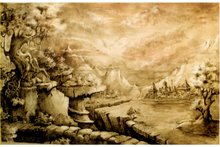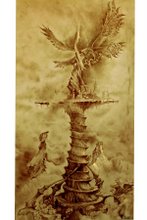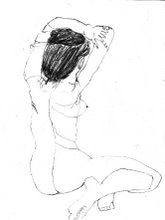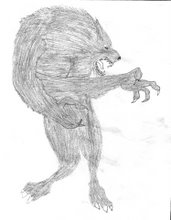Monday, February 26, 2007
Sunday, February 25, 2007
Saturday, February 24, 2007
Friday, February 23, 2007
Monday, February 19, 2007
Thursday, February 15, 2007
Tuesday, February 13, 2007
Wednesday, February 7, 2007
Edwin Austin Abbey
 | Portrait of Abbey (ca 1889) | |
 Born in 1852, Edwin Austin Abbey was on staff at Harpers by the time he was 19 and, despite success, recognition and raises, he left to pursue a free-lance career at the age of 22. He returned to Harpers in 1876, at the ripe old age of 24, a wily veteran at the princely sum of $50 a week (more than three times his 1871 initial salary). 1876 was also the American Centennial and one of the many celebratory events was the Centennial Exhibition which brought a wide selection of European paintings to Philadelphia. Abbey was inspired by the English contingent: Leighton, Watt, Boughton, and others. Already a proponent of drawing from life, the work of the Pre-Raphaelites inspired him further. This led to a journey to England in 1878 in the cause of accuracy in his drawings for Herrick's Poems. He remained there for most of his life.
Born in 1852, Edwin Austin Abbey was on staff at Harpers by the time he was 19 and, despite success, recognition and raises, he left to pursue a free-lance career at the age of 22. He returned to Harpers in 1876, at the ripe old age of 24, a wily veteran at the princely sum of $50 a week (more than three times his 1871 initial salary). 1876 was also the American Centennial and one of the many celebratory events was the Centennial Exhibition which brought a wide selection of European paintings to Philadelphia. Abbey was inspired by the English contingent: Leighton, Watt, Boughton, and others. Already a proponent of drawing from life, the work of the Pre-Raphaelites inspired him further. This led to a journey to England in 1878 in the cause of accuracy in his drawings for Herrick's Poems. He remained there for most of his life.
 His pen work, though always excellent, took on a new dimension. The sketching "rambles" he experienced in England with Alfred Parsons and George Boughton reinforced his belief in the value of drawing from the source. His ink drawings were still being engraved on wood, so some of the spontaneity is lost. Like Daniel Vierge, Abbey was quick to see the advantage of "process" reproduction of his pen drawings ("process" being any of several photographic processes that eliminated the engraver's reinterpretation). While in England he produced illustrations for many Harpers serials including "She Stoops to Conquer" (collected as a sumptuous book in 1887), "Old Songs" (right, above), and "Judith Shakespeare" (the first two were also published in book form with Abbey's illustrations). While in Europe, he met and was inspired by the great French and English artists of the day. His friendship with Sargent is evidenced by the portrait at the top of this page. Abbey often lived at his studio in Broadway and they painted together often. He was also friends with Alma-Tadema, DuMaurier, Whistler, and others. And though he was painting throughout, he still was using the pen as his primary artistic tool. This prowess with the pen led Harpers to assign him a series of illustrations for Shakespeare's comedies in 1887.
His pen work, though always excellent, took on a new dimension. The sketching "rambles" he experienced in England with Alfred Parsons and George Boughton reinforced his belief in the value of drawing from the source. His ink drawings were still being engraved on wood, so some of the spontaneity is lost. Like Daniel Vierge, Abbey was quick to see the advantage of "process" reproduction of his pen drawings ("process" being any of several photographic processes that eliminated the engraver's reinterpretation). While in England he produced illustrations for many Harpers serials including "She Stoops to Conquer" (collected as a sumptuous book in 1887), "Old Songs" (right, above), and "Judith Shakespeare" (the first two were also published in book form with Abbey's illustrations). While in Europe, he met and was inspired by the great French and English artists of the day. His friendship with Sargent is evidenced by the portrait at the top of this page. Abbey often lived at his studio in Broadway and they painted together often. He was also friends with Alma-Tadema, DuMaurier, Whistler, and others. And though he was painting throughout, he still was using the pen as his primary artistic tool. This prowess with the pen led Harpers to assign him a series of illustrations for Shakespeare's comedies in 1887.
 After a short trip back to New York in 1889, he immediately returned to England, where the lure of authentic costumes could not be denied. On the trip, he convinced himself that his future should be in oil painting. The Shakespeare illustrations, which would continue until 1909, were executed in many media: pen, oil, watercolor and pencil. These were some of his first published oil paintings and his European experience continued to pay dividends. At left/above is The Play Scene in Hamlet from 1897. Though not part of the Harpers series (this being a submission to the Royal Academy of that year), the composition, staging and power of his work from this period is stunning. And the access to the costumes and stage props so readily available in England lends a sense of reality often missing elsewhere. He also traveled to Italy for more research.
After a short trip back to New York in 1889, he immediately returned to England, where the lure of authentic costumes could not be denied. On the trip, he convinced himself that his future should be in oil painting. The Shakespeare illustrations, which would continue until 1909, were executed in many media: pen, oil, watercolor and pencil. These were some of his first published oil paintings and his European experience continued to pay dividends. At left/above is The Play Scene in Hamlet from 1897. Though not part of the Harpers series (this being a submission to the Royal Academy of that year), the composition, staging and power of his work from this period is stunning. And the access to the costumes and stage props so readily available in England lends a sense of reality often missing elsewhere. He also traveled to Italy for more research.
 In 1890 he received the commission for the Holy Grail murals at the Boston Public Library. The first half were completed and installed in 1895, the remainder in 1901. That year Abbey was elected President of the Royal Birmingham Society of Artists. He lived in London until his death in 1911.
In 1890 he received the commission for the Holy Grail murals at the Boston Public Library. The first half were completed and installed in 1895, the remainder in 1901. That year Abbey was elected President of the Royal Birmingham Society of Artists. He lived in London until his death in 1911.
 Another easel painting was The Crusaders Sighting Jerusalem from 1901, at left. Again, his insistence on accuracy provides a most dynamic image. Always a popular artist, in 1902, he illustrated an edition of Oliver Goldsmith's The Deserted Village (Goldsmith also wrote She Stoops to Conquer, one of his earliest successes). The illustration at right demonstrates the continued development with the pen, especially is the sense of spontaneity of line.
Another easel painting was The Crusaders Sighting Jerusalem from 1901, at left. Again, his insistence on accuracy provides a most dynamic image. Always a popular artist, in 1902, he illustrated an edition of Oliver Goldsmith's The Deserted Village (Goldsmith also wrote She Stoops to Conquer, one of his earliest successes). The illustration at right demonstrates the continued development with the pen, especially is the sense of spontaneity of line.
 That year, Abbey also accepted his second great mural commission: the new state capitol at Harrisburg, Pennsylvania. The images for these murals show him working from the nude model and the resultant figure studies, like Men at an Anvil at right, leave absolutely no doubt as to his prowess and talent. It's just an oil sketch, circa 1904-08, but the intensity and strength is amazing. Abbey died before completing the murals. They were finished by J.S. Sargent. A most excellent biography by E.V. Lucas, with two hundred b&w, mostly photogravure, illustrations, was published in 1921 titled: Life and Work of Edwin Austin Abbey, R.A. It is highly recommended. A limited edition with an original Abbey drawing exists.
That year, Abbey also accepted his second great mural commission: the new state capitol at Harrisburg, Pennsylvania. The images for these murals show him working from the nude model and the resultant figure studies, like Men at an Anvil at right, leave absolutely no doubt as to his prowess and talent. It's just an oil sketch, circa 1904-08, but the intensity and strength is amazing. Abbey died before completing the murals. They were finished by J.S. Sargent. A most excellent biography by E.V. Lucas, with two hundred b&w, mostly photogravure, illustrations, was published in 1921 titled: Life and Work of Edwin Austin Abbey, R.A. It is highly recommended. A limited edition with an original Abbey drawing exists.
 The research Abbey did for the Harpers Shakespeare Comedies and Tragedies series was put to excellent use in his many award-winning easel paintings. The wrap-around fold-out cover of the 1974 Yale University Exhibition Catalog (at left) is from Richard III, Richard, Duke of Gloucester, and the Lady Anne, from 1896. (Richard, in red, is proposing to the widow of the man he has just murdered in the midst of the funeral procession.) This catalog is an excellent source of information on and images by Abbey. It provides some of the few color reproductions I've seen (though The Illustrator in America has two - including Richard...). The many illustrations done for the turn-of-the-century magazines were all reproduced in b&w and were most likely executed in tones rather than color.
The research Abbey did for the Harpers Shakespeare Comedies and Tragedies series was put to excellent use in his many award-winning easel paintings. The wrap-around fold-out cover of the 1974 Yale University Exhibition Catalog (at left) is from Richard III, Richard, Duke of Gloucester, and the Lady Anne, from 1896. (Richard, in red, is proposing to the widow of the man he has just murdered in the midst of the funeral procession.) This catalog is an excellent source of information on and images by Abbey. It provides some of the few color reproductions I've seen (though The Illustrator in America has two - including Richard...). The many illustrations done for the turn-of-the-century magazines were all reproduced in b&w and were most likely executed in tones rather than color.
Abbey can lay claim to being America's first great illustrator. His work was inspirational and influential during his life and remains so today. He's one of our most demanded artists.

Tuesday, February 6, 2007
Andrew Loomis
 |
|
 Figure Drawing For All It's Worth in abridged form from Walter T. Foster Art Books, it's still in print today - 55 years after publication. That's a pretty ringing endorsement for his teaching skills.
Figure Drawing For All It's Worth in abridged form from Walter T. Foster Art Books, it's still in print today - 55 years after publication. That's a pretty ringing endorsement for his teaching skills.
Loomis was born in 1892 in Syracuse, New York. Walt and Roger Reed in The Illustrator in America say that "it was a visit to the nearby studio of Howard Chandler Christy that made him decide to seek for himself an artist's career." He studied in New York at the Art Students League under George Bridgman and F.V. du Mond when he was 19 and went back to the Midwest (he grew up in Zanesville, Ohio) in 1915 to Chicago to work in an art studio there. He continued his education at the Chicago Art Institute.

![]() After military service in World War I, Loomis worked for a couple of advertising agencies before opening his own studio at 360 North Michigan Avenue in downtown Chicago where he listed his "subjects" as "Character Studies, Figures, Historical Subjects, Interiors, Covers, Posters, Portraits, Still Life, Landscapes" and his "mediums" as "Black and white, Charcoal, Color, Dry Brush, Oil, Watercolor, Pastel, Wash." At left is a sample of his work from 1928.
After military service in World War I, Loomis worked for a couple of advertising agencies before opening his own studio at 360 North Michigan Avenue in downtown Chicago where he listed his "subjects" as "Character Studies, Figures, Historical Subjects, Interiors, Covers, Posters, Portraits, Still Life, Landscapes" and his "mediums" as "Black and white, Charcoal, Color, Dry Brush, Oil, Watercolor, Pastel, Wash." At left is a sample of his work from 1928.
 At right is his only cover for The Saturday Evening Post, from 1935. (Image from The Illustrator in America: 1880-1980) He produced commercial art his entire career, but in researching my collection to find images to include here, his work remained maddeningly elusive. Check our
At right is his only cover for The Saturday Evening Post, from 1935. (Image from The Illustrator in America: 1880-1980) He produced commercial art his entire career, but in researching my collection to find images to include here, his work remained maddeningly elusive. Check our ![]() page for a link to Illustration House which has featured many Loomis pieces in their auctions. It was as a teacher, more than as an illustrator, that he made a very lasting impression upon the artists that came after him.
page for a link to Illustration House which has featured many Loomis pieces in their auctions. It was as a teacher, more than as an illustrator, that he made a very lasting impression upon the artists that came after him.
 He taught at the American Academy of Art, in Chicago, during the 1930s and that it was there he perfected the teaching techniques that he codified in his first book, Fun With a Pencil, in 1939. The self-portrait/caricature at the top of this page is the final illustration in that book. It's 120 pages in b&w and blue and the focus is cartooning, though there are lots of very solid illustration tips as well. And it really is fun! The tone is light-hearted, but the information is carefully and skillfully presented. It's no surprise that it was popular.
He taught at the American Academy of Art, in Chicago, during the 1930s and that it was there he perfected the teaching techniques that he codified in his first book, Fun With a Pencil, in 1939. The self-portrait/caricature at the top of this page is the final illustration in that book. It's 120 pages in b&w and blue and the focus is cartooning, though there are lots of very solid illustration tips as well. And it really is fun! The tone is light-hearted, but the information is carefully and skillfully presented. It's no surprise that it was popular.
And it was very popular! By 1943 it had gone through six printings. This response was sufficient to induce Loomis to write another instructional book that year, the ever-popular Figure Drawing For All It's Worth, mentioned above. I use the phrase "ever-popular" advisedly as by 1973 the book was in its 25th printing, and the fact that I sold so many copies is due to the continued demand from artists, young and old, who want to take advantage of the seminal content. It's an amazing book that actually lives up to its reputation. It's 204 pages of solid anatomy for illustrators, profusely illustrated, primarily with pencil drawings. By 1946 it was in its 12th printing.
 The next book would be his masterpiece. The 1947 Creative Illustration was aimed at the professional illustrator. It was 300 pages divided into seven sections: Line, Tone and Color were the three introductory parts. Then came the four sections that make this book still relevant today - Telling the Story, Creating Ideas, Fields of Illustration, and Experimenting and Studies.
The next book would be his masterpiece. The 1947 Creative Illustration was aimed at the professional illustrator. It was 300 pages divided into seven sections: Line, Tone and Color were the three introductory parts. Then came the four sections that make this book still relevant today - Telling the Story, Creating Ideas, Fields of Illustration, and Experimenting and Studies.
 The Color section was in color - definitely not a common practice at that time. The page at right shows a variety of tonal studies from palettes based on color schemes. The book is filled with instructions, tips, insider experiences, and incredible illustrations.
The Color section was in color - definitely not a common practice at that time. The page at right shows a variety of tonal studies from palettes based on color schemes. The book is filled with instructions, tips, insider experiences, and incredible illustrations.
Telling the Story leads off with the powerful image at left, a story in itself. Every chapter, every page, every picture is prime information for the artist and Loomis manages to convey it clearly and concisely. Creative Illustration is a dynamite book!
In 1951 he released Successful Drawing with more advanced fundamentals. This title was re-released in a slightly altered form in 1961 as Three-Dimensional Drawing.
 Drawing the Head and Hands was next, in 1956. It took the information presented in Fun With a Pencil and Figure Drawing For All It's Worth, expanded it, clarified it, and presented it in 155 pages of new text and art. The importance of this title in the Loomis canon can't be emphasized enough, and students are still clamoring for copies, with prices over $100 on even the most available titles.
Drawing the Head and Hands was next, in 1956. It took the information presented in Fun With a Pencil and Figure Drawing For All It's Worth, expanded it, clarified it, and presented it in 155 pages of new text and art. The importance of this title in the Loomis canon can't be emphasized enough, and students are still clamoring for copies, with prices over $100 on even the most available titles.
Which leads us inevitably into the question of why aren't these books being reprinted? All I can say is "I don't know." I've heard all kinds of rumors and speculations, but the purpose of these pages is not to deal with anything other than facts, so it's still as much a mystery to me as it is to you. The Walter T. Foster company seems to have some access to the material from some of the books and Bud Plant Comic Art has a few titles available. Maybe the W.T. Foster people know something they could share with us?
The elusive and intriguingly titled Eye of the Painter and Elements of Beauty is Loomis' last book, published posthumously in 1961, two years after his death. It's his treatise on how an artist perceives beauty and harmony. It's an interesting book, but it's not for casual perusal and doesn't have all that much Loomis art. It's mainly illustrated with samples of the work of fine artists..
Winsor McCay(1871-1934)
Winsor McCay + Little Nemo = fame and fortune. The End. Not quite that easy. For starters, McCay was born in 1867 (the same year as Frank Brangwyn, Arthur Rackham and Sidney Sime) and had an eccentric and checkered career behind him when he moved to New York in 1903. It still wasn't until two years later, at the age of 38, that he started the Little Nemo Sunday comic strip in October of 1905. In his very excellent Winsor McCay - His Life and Art, John Canemaker chronicles his prolific, inventive, strange and often heart-breaking career. I summerize below.
| ||
| |
Winsor McCay c.1906
(collection of Ray Winsor Moniz)
Winsor McCay was born Zenas Winsor McKay in 1867, probably in Canada. He was named after his father's employer and he quickly dropped Zenas in favor of Winsor. He was raised in Michigan, where he commenced drawing at a prodigiously early age. And never stopped. At the age of 13 he drew a picture of shipwreck on the school blackboard and it was photographed and copies sold. His attention to (and memory of) detail was amazing. Winsor McCay, the boy, loved to draw and was very good at it.
So how come some families embrace their artistic children and others go out of their way to suppress them? McCay's father (who by now had dropped the "K" in favor of the "C") belonged to the latter group. At the age of 19, he enrolled Winsor in a business school in order to learn a real trade (just like Arthur Rackham's family tried to turn him into a clerk). Young Winsor chaffed at the lessons (when he attended) but reveled in being 100 miles distant from his family and that much closer to Detroit.
One of the normal forms of entertainment of the day was the Dime Museum. These establishments were designed to separate people from their money. Part circus, part amusement park and part vaudeville, they featured both transient and permanent acts and exhibits. McCay's first job that earned him money from his art was at Wonderland in Detroit where he was hired to draw portraits of the customers for 25¢ each. His facility for observation and his amazingly ability to draw quickly made him a popular 'attraction.' It also brought out his intense desire to please with his art. He really needed to draw, but even more he needed the approbation. He got some from the customers, but more importantly, he took some extracurricular drawing lessons from a local instructor who thought highly of his work. The teacher's forte was perspective and McCay had to have been the star pupil judging from the good use to which he put the lessons later in life.

But I'm getting ahead of myself. McCay left Michigan for Chicago in 1889 where he worked for a printer and roomed with Jules Guerin. In 1891 he moved to Cincinnati. There he settled into the only type of work he knew - he went to work as a staff artists for a local dime museum. He married, had two children, and took on extra work painting signs and, eventually, making drawings for a local newspaper. It was there that he first developed his skill with a pen - everything up to that point had been crafted with pencil and brush. He also supplemented his income by submitting drawings to the humor magazine, Life, beginning in 1899.

One of Canemaker's favorites from Life, and mine as well (and Harvey Kurtzman liked it enough to reprint it in an issue of Help, too), is a six-panel masterpiece that anticipates cinemascope, camera tracks and pans, and even special effects. This was 1903 and McCay was obviously ready for the big time. As Canemaker points out, his accurate renditions of galloping horses indicate a familiarity with Eadweard Muybridge's photographic motion studies of 1887. Few cartoonists had mastered the cartoon pacing and motion better than McCay at this time, and his one foray into the Sunday comic strip, Tale of the Jungle Imps was equally advanced. He was just a small-town, hard-working artist from Cincinatti. What could he do in New York?
 An invitation to take a job at the New York Herald prompted McCay to find out. In late 1903, he relocated and began the most prolific chapter of his cartooning life. From 1904-1911, McCay produced a string of comic strips that have overridden many of his other accomplishments. While I would never minimize the value of his comic strip work, you have to understand that McCay was driven to draw. Whatever those inner demons were, he was compelled by them to draw and draw and draw. His output during these eight years surpasses the lifetime work of some equally famous cartoonists.
An invitation to take a job at the New York Herald prompted McCay to find out. In late 1903, he relocated and began the most prolific chapter of his cartooning life. From 1904-1911, McCay produced a string of comic strips that have overridden many of his other accomplishments. While I would never minimize the value of his comic strip work, you have to understand that McCay was driven to draw. Whatever those inner demons were, he was compelled by them to draw and draw and draw. His output during these eight years surpasses the lifetime work of some equally famous cartoonists.
In early 1904, there were three abortive attempts at newspaper strips: Mr. Goodenough, Sister's Little Sister's Beau, and The Phurious Phinish of Phoolish Philipe Phunny Phrolics. The real explosion of effort began, appropriately enough, with Little Sammy Sneeze.
 Little Sammy sneezed every Sunday from July 24, 1904 to December 9, 1906. Since everyone knew what was going to happen in each strip, it was the build-up that mattered. Each strip was exactly six panels with the last reserved for Sammy's comeuppance, so pacing was everything. And it worked for 2½ years.
Little Sammy sneezed every Sunday from July 24, 1904 to December 9, 1906. Since everyone knew what was going to happen in each strip, it was the build-up that mattered. Each strip was exactly six panels with the last reserved for Sammy's comeuppance, so pacing was everything. And it worked for 2½ years.
Not content to do just one strip, he began Dream of the Rarebit Fiend on September 10, 1904. His most successful strip, this ran until June 25, 1911. It was for a different paper and signed "Silas". Dream was a thoroughly adult strip devoted to adult nightmares and phobias - all caused by overindulging in Welsh rarebit (or cheese pie) just before bed. At right, it's the size of the new hat and the husband's imagined reaction that disrupts the wife's sleep.
For all the sophistication of McCay's drawings, the other aspects of his strips were never very polished. The word balloons and lettering were always merely adequate and the writing seemed to be an afterthought, hurriedly composed to carry a visual joke.
Still not drawing enough, McCay created The Story of Hungry Henrietta from January 8 through July 16, 1905. In a very modern take on child-rearing, this was the story of a young girl raised by a loud and self-absorbed family that continues to proffer food in place of love. Henrietta is happiest in the last panel when she's given a treat instead of a hug.
In search of salve for the drawing demon, McCay began A Pilgrim's Progress on June 26, 1905. It ran for more than five years, ending on December 18, 1910.
All of these strips were formula based, requiring only a new setting for Sammy to sneeze at, a new nightmare to exaggerate, another situation for the parents to ignore Henrietta's real needs, and another attempt by Mr. Bunion to rid himself of the valise of 'Dull Care'. This formulaic approach allowed McCay to invest all of his creativity in the drawing. Even the panel shapes and sizes of each strip were fairly stable (with Rarebit Fiend being the most experimental). So with three strips running each week in two different newspapers, as well as other daily cartoons and drawings for the Herald, McCay was finally ready to create his masterpiece. And on October 15, 1905, Little Nemo in Slumberland debuted.

Simply put, Little Nemo revolutionized the comic strip. At 38, McCay was at the very peak of his talent and the New York Herald had the most talented and creative color printing staff in the business. Together they crafted a weekly fantasy that week by week revealed Slumberland to be more magical than even L. Frank Baum's Oz (created in 1899) and more wonderful than Lewis Carroll's Wonderland (1865). Books and websites abound praising Nemo far more than I could possibly do in this short bio. Nemo was published in the New York Herald until July 23, 1911. The strips have been reprinted many times. Find them and lose yourself in this masterpiece. It wasn't syndicated, so the fame of the strip is based on the readers of just one paper.
Well, not entirely. 1905 was heyday of vaudeville and a frequent feature was the chalk-talk artist - an artist who could stand in front of an audience and draw on a chalk board. Nemo was an immediate hit and McCay, who liked nothing better than to draw (and never seemed to have enough money, no matter how much he made), took to the boards on June 11, 1906. He was a hit, there, too. As his bookings along the east coast increased, so did the logistical difficulties of producing three weekly comic strips and other drawings for the papers. Many strips from this period were drawn in backstage dressing rooms and in hotels as he toured with his act. When Little Nemo made it to Broadway in 1908, McCay was performing his chalk-talk across the street and had to miss a portion of opening night. The approbation of the live audience was just as crucial to him as the regard of those watching the musical based on his work.
 Within five years of arriving in New York, McCay had become one of the top artists and performers in the city. Both his comic strips and his vaudeville act were based on pacing and movement. He was about to combine all of these elements into one new art - the animated cartoon.
Within five years of arriving in New York, McCay had become one of the top artists and performers in the city. Both his comic strips and his vaudeville act were based on pacing and movement. He was about to combine all of these elements into one new art - the animated cartoon.
While he wasn't the first person to make an animated cartoon, he was the man who defined the industry. The quality of his cartoons would not be matched for another 25 years. His pacing and understanding of the medium was far ahead of his time. And he drew all of the 4,000 cels of his first film, Little Nemo, (natch!) himself! This while he was still drawing his three strips and performing his vaudeville act. The Little Nemo film was released to theater and used in his act, as was his second. How a Mosquito Operates - this 6,000 drawings long. When these films were released into wider distribution, McCay's fame spread, especially to the fledgling animation community.
When the Herald rejected his request to take some time off to go perform in Europe, McCay waited until his contract was up and jumped over to the Hearst paper, The American, in July of 1911. The Herald lost its star of three strips, and McCay lost his freedom.
All McCay wanted to do was draw. All Hearst wanted was someone who did as he was told. Drawing meant performing to McCay and it meant expanding his knowledge of animation. Nemo was published in the Hearst papers under the title In the Land of Wonderful Dreams, since the Herald owned the Nemo name. The coloring was less than what he was used to and he was devoting most of his energy to his next animated film, Gertie the Dinosaur. The lack of attention showed, especially in blandness of the 27 daily strips he created for Hearst from 1911 to 1913. His editorial cartoons were masterpieces of pen work, and that's where Hearst decided to relegate his talents.
On December 13, 1913, he was told by his employer that he was to give up his comic strips and do "serious" editorial work. In February of 1914, Gertie debuted to stunning reviews. McCay projected the film on his white sketch pad and in a carefully choreographed sequence interacted with the animated dinosaur and actually joins her on screen for the finale. A filmed opening was attached to the animation for theater distribution. (See above for one drawing from the thousands he made to create the film.)

McCay's east coast vaudeville bookings began to dry up as Hearst made it known to the proprietors that he would 'prefer' that they not engage McCay. In 1914, McCay signed a contract with Hearst not to appear outside of New York City. Now all McCay had to look forward to each day was a compulsory appearance at the newspaper office and making pen & ink editorial cartoons that stretched across all eight columns of the editorial page. These large drawings needed lots of visual interest since most of the editorial stances they illustrated were fairly simplistic. A world war was coming and Hearst was agin it.
 McCay's personal beliefs are often considered to be reflected by these editorial drawings. While I don't claim special knowledge of his mindset, I do know that his last major animated film was a recreation of the sinking of the Lusitania and amounted to a call to arms. Hearst and his editor Arthur Brisbane actually lobbied in the paper for understanding of Germany's position on the matter. I can't imagine a more repressive occupation than being forced to put forth a public face that was the opposite of your own. And the lack of humor in all of these drawings must have been depressing, too. But the drawings, themselves, were magnificent. Click the image above for a sad sample of a great talent in the service of a small idea.
McCay's personal beliefs are often considered to be reflected by these editorial drawings. While I don't claim special knowledge of his mindset, I do know that his last major animated film was a recreation of the sinking of the Lusitania and amounted to a call to arms. Hearst and his editor Arthur Brisbane actually lobbied in the paper for understanding of Germany's position on the matter. I can't imagine a more repressive occupation than being forced to put forth a public face that was the opposite of your own. And the lack of humor in all of these drawings must have been depressing, too. But the drawings, themselves, were magnificent. Click the image above for a sad sample of a great talent in the service of a small idea.
In 1924 he left Hearst and returned to the now Herald Tribune and tried to revive Little Nemo. It lasted for two years, but proved to be out of touch with the public. McCay was allowed to purchase all rights to the character for $1 - a magnanimous gesture that doubled as a sad evaluation of his efforts.
He died in 1934 after spending his last eight years back at the American drawing editorial cartoons for Arthur Brisbane. McCay was a light-hearted man who just wanted to make beautiful pictures. He wanted animation to be an art. He wanted newspaper strips to appeal to the eye and the soul. He wanted to draw. No matter how many barriers stood in his way, he managed to accomplish that. Still, he's best remembered for one strip he drew for only six years. That alone would have been a magnificent legacy. Thankfully, there is so much more.










